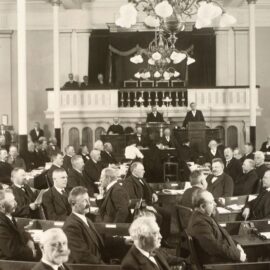

This article gives you a glimpse of what you can learn with Shortform. Shortform has the world’s best guides to 1000+ nonfiction books, plus other resources to help you accelerate your learning.
Want to learn faster and get smarter? Sign up for a free trial here .
Is language biological or learned? What factors crucially impacted the evolution of communication?
Language connects people all around the world. Without it, humans wouldn’t get far in life because they wouldn’t be able to communicate with each other. Yet, we’ve managed to go from using language purely as a survival tool to forming relationships with online friends.
Let’s dive into the evolution of communication to see how far we’ve come.
Language Is Biologically Innate
To get a full grasp of the evolution of communication, there needs to be an understanding of where language comes from. Steven Pinker’s underlying argument in his book The Language Instinct is that language is a biologically derived skill and not something that is purely learned from the environment. He elaborates on this theory by asserting that there are universal elements of grammar in all languages and by explaining that language is an evolutionary adaptation.
Language Is an Evolved Trait
Pinker writes that language is a genetic adaptation that arose from natural selection in early human communities. He says that language could have started evolving four to seven million years ago, although it’s unclear if Neanderthals (an extinct human subspecies) had language. Pinker suggests that random genetic variation might have enabled some humans to express themselves with more nuance than before, and then people with this skill were more likely to survive longer, reproduce, and pass on their language skills.
Pinker argues that language would have increased humans’ chance of survival by allowing them to express abstract ideas and complex logic. For example, language would help people talk about where they discovered a new potential place to take shelter or warn others of danger by telling a story. Pinker also writes that language would have helped people cooperate and rally together to defeat rivals. He claims that it would have enhanced people’s ability to persuade others—possibly increasing political power for those who were skilled orators. Because of these advantages, natural selection continuously favored people who could express and interpret early forms of language.
Universal Grammar
In addition to describing the evolution of communication and language, Pinker asserts that commonalities among all human languages support the idea that language is biologically innate. This concept is called the Universal Grammar hypothesis. According to Pinker, these universal components include subjects, objects, verbs, phrase structures, and syntax (which determines the relationships between words and phrase types). He argues that although languages seem diverse due to their variation in sounds, words, and sentence structure, the more significant feature of language is its consistent blueprint.
The History of English
Now that we know a bit about the origins of language, let’s look at the history of one of the most spoken languages in the world: English. Understanding how English has advanced helps us understand the evolution of communication across cultures.
According to Bill Bryson’s book The Mother Tongue, most of the languages of Europe and Asia belong to one great Indo-European family of languages. English is a member of the Germanic family of languages (the West Germanic branch, to be precise), which is itself part of the larger Indo-European language family.
The story of English began when Germanic peoples known as the Angles and Saxons, hailing from what is now Northern Germany, began migrating to and conquering the Roman province of Britannia in the mid-5th century CE. These Angles and Saxons brought their Germanic language to their new home, where it morphed over time into the language we now call Old English. Some of our most fundamental words today come from Old English, particularly words related to family—man, wife, child, brother, and sister, to name a few. Old English was a rich literary language as well, leaving behind a trove of letters, charters, religious works, and legal texts. Old English works like Beowulf and Caedmon’s Hymn are the starting points of English literature.
From the 8th to the 10th centuries CE, the British Isles were invaded and settled by the Vikings of Scandinavia. The Viking immigrants and their Norse language further enriched the Old English vocabulary, adding important words like husband, sky, and leg. Old English also absorbed syntax and grammatical structure from Old Norse, a testament to the language’s fluidity, even at this early stage in its development.
In 1066, the Norman king William I conquered England and displaced the reigning Anglo-Saxon ruling elite. Norman-French came to exert its own powerful influence on English vocabulary and structure—no fewer than 10,000 words can be traced to the time of the Norman Conquest.
Historical Evolution of English
Throughout the later Middle Ages, English evolved organically and developed many of its more recognizable features. One such feature was uninflected verbs with stable consonants (in other words, they are mostly the same regardless of gender, tense, case, and mood). Another was the simplification of noun endings to denote plurals (almost all English nouns are today pluralized with the addition of a simple s at the end).
In England, the speech patterns of the capital city of London came to establish the standard for how the language was spoken in the rest of the country, although this was a long and uneven historical process that didn’t happen all at once or with the same speed everywhere. Vestigial features of older forms of the language remain in place to this day, with archaic pronouns like thee and thou still spoken in parts of Yorkshire.
Perhaps the most famous change in pronunciation was the Great Vowel Shift running roughly from 1400-1600 CE, during which English speakers began pushing vowels closer to the front of their mouths. The word life, for example, was pronounced lafe in Shakespeare’s time, with the vowel lodged further back in the throat.
At this time, English began to be regarded for its potential as a language of literature. No writer took greater advantage of the incredible flexibility and richness of the English language than Shakespeare. The Bard of Avon alone added some 2,000 words to the language, such as mimic, bedroom, lackluster, and hobnob. He also introduced a host of new phrases we still use today, like “one fell swoop” and “in my mind’s eye.” Shakespeare greatly elevated and exalted the English language.
For much of the history of the language, however, words defied standard spelling, with even Shakespeare offering a bewildering array of different and inconsistent spellings for the same words throughout his works. The first steps toward standardization only began with the invention of the printing press in the 15th century and the gradual spread of written works (and thus, literacy) throughout England.
By 1640, there were over 20,000 titles available in English, more than there had ever been. As printed works produced by London printers began to spread across the country, local London spelling conventions gradually began to supplant local variations. What this also meant was that old spellings became fixed just as many word pronunciations were shifting because of the Great Vowel Shift. Our inheritance is a written language with many words spelled the way they were pronounced 400 years ago.
As a result, English spellings often bedevil non-native speakers, as well as those who’ve spoken the language their whole lives. Pronunciation and spelling are frequently divergent. To take just one example, the sh sound can be spelled sh as in mash; ti as in ration; or ss as in session. The troublesome orthography (the set of conventions for writing) of English can be seen in words like debt, know, knead, and colonel, with their silent letters, as well as their hidden, but pronounced letters.
Language and Communication Form Nationalism
We now have an understanding of how language and English have evolved. But how have we come to use language to form communities and identities with other people? In Imagined Communities, Benedict Anderson argues that one of the key factors in the rise of nationalism was the explosion of literacy in Europe beginning in the 14th and 15th centuries.
He writes that the new reading public that began to emerge in most European countries was able to absorb written ideas and communicate with one another in the languages they spoke every day. This, in turn, formed a crucial link that sparked national consciousness and forged key bonds of commonality between previously disunited political communities within European countries.
Literacy Initially Cemented a Ruling Class
Anderson argues that one of the primary bonds that had linked otherwise disparate political and religious elites together before the rise of the nation-state was their shared use of ancient sacred languages.
According to Anderson, liturgical languages like Latin, Classical Chinese, and Koranic Arabic helped to join the tiny educated elite (an infinitesimal fraction of the overall population, the overwhelming majority of which was completely illiterate) together across vast stretches of time and space. The fact that these were dead tongues—read and written, but not used in ordinary conversation—gave them a unique power.
Because they existed almost entirely in writing, these languages were relatively unchanged throughout the centuries or across countries. In Europe, this meant that those scribes, scholars, and monks from Ireland to the furthest reaches of the Holy Roman Empire who possessed a shared understanding of Latin could cement their solidarity as Europe’s educated elite—regardless of what country they were from.
Anderson also notes that these languages were used almost exclusively in the context of either sacred religious ceremonies, legal contracts, or royal proclamations. This gave them a weight and gravity that common languages didn’t possess and positioned the small community of princes and churchmen who had mastered them as intermediaries between the common masses and the realm of the sacred.
The Printing Press Democratized Literacy
Literacy rates would eventually come to soar in Europe, paving the way for vernacular languages to supplant Latin as the dominant language of written expression.
Anderson argues that the massive growth in literacy beginning in the 14th and 15th centuries was made possible by the printing press, an important step in the evolution of communication. For the first time, books and pamphlets could be mass-produced by machine rather than painstakingly hand-copied—making them much more inexpensive and widely available. Indeed, Anderson writes that 20,000 titles were published in Europe by the year 1500, an increase many orders of magnitude beyond what had been possible before.
This gave the European general public far greater access to the world of words than they’d ever had before. The emerging bookselling and publishing industry naturally sought the broadest possible market for its products. Since only a tiny educated minority of the population was literate in Latin, it took very little time to saturate this market. Simple economic logic, therefore, dictated that books be printed in the vernacular—the languages that people spoke and used every day.
This helped to boost literacy rates because it was easier for people to learn to read and write in languages they already spoke. Within a few generations, according to Anderson, there was a genuine mass reading public in Europe, and people communicated stories to each other through books.
How the Telegraph and Television Changed Communication
The evolution of communication took a turn when technology advanced in the 19th and 20th centuries. Politicians of the 20th century quickly learned that the medium or form of communication dictates messages, and they accommodated themselves to television. In fact, our forms of communication throughout history have similarly dictated what was communicated and shaped the culture. Television is just one of the latest examples, says Neil Postman in his book Amusing Ourselves to Death.
For example, native Americans communicated with smoke signals, but the form—puffs of smoke—precluded complicated messages like a discussion of philosophy. (You can’t convey philosophy on television, either—its form of communicating in images rather than words requires more simplistic content.)
The telegraph was another medium whose form or design determined the information it delivered. The kind of information that Americans have come to think of as the “news of the day” didn’t exist until the telegraph was invented and delivered it.
The telegraph made it possible to move bits of disparate information lacking any context over long distances at incredible speed. Previously inaccessible information about fires, wars, and murders in far-flung places became part of local conversations and culture despite lacking local relevance.
Today, we’ve adapted to receiving the “news of the day” in a fragmented form because television and other electronic media are designed to deliver it this way. Cultures that communicated information over long distances by smoke signals didn’t have “news of the day.”
Communicating With Social Media
In today’s world, many relationships are formed online. AOL Instant Messenger was once a popular chat program to communicate in real-time, and today people can easily talk to anyone using direct messages (DMs) on Instagram or Twitter. But communicating in virtual spaces have their own set of unique rules and challenges. With that in mind, in this section, we’ll discuss some basic facts about online friendships from Jack Schafer and Marvin Karlins’ book The Like Switch.
- It’s easy to find people with common interests. According to Schafer and Karlins, it’s easy to make friends online because it’s easy to find common interests. There are thousands of strangers online who watch the same shows as you, play the same sports as you, have the same hobbies as you, and so on, and they’re all right at your fingertips.
- It’s easy to enter and leave intense connections. The authors note that online relationships often intensify quickly because the barrier of the screen makes people feel more comfortable sharing traits they’d normally hide. The relative anonymity means there’s less risk of embarrassment sharing things online than there is in person, and it’s easier to exit uncomfortable situations. If the other person says something that makes you feel uneasy, rejected, or offended, all you have to do is exit the webpage or the app to escape the situation: You don’t have to face backlash from the other person in real-time.
- You can’t use nonverbal cues to understand people’s intentions. Online relationships also come with unique dangers. The authors claim that without access to the nonverbal cues that let our brains know whether someone is a potential friend or enemy, it’s difficult to judge someone’s intentions. Additionally, though the internet offers more anonymity than in-person interactions, there’s always a chance that the things you post and write online may be accessible forever. This becomes a problem if you post information or photos that put you in a compromising position.
Final Words
Many people today couldn’t imagine communicating as the Neanderthals did without phones, television, or social media. That’s the beauty of communication—it’s constantly evolving with technology, showing how language is the foundation of all relationships. In a century’s time, there will probably be a new way to talk to others and they’ll look back on the simple ways we communicate with each other.
How insightful was our breakdown of the evolution of communication? Let us know in the comments below!

Want to fast-track your learning? With Shortform, you’ll gain insights you won't find anywhere else .
Here's what you’ll get when you sign up for Shortform :
- Complicated ideas explained in simple and concise ways
- Smart analysis that connects what you’re reading to other key concepts
- Writing with zero fluff because we know how important your time is






